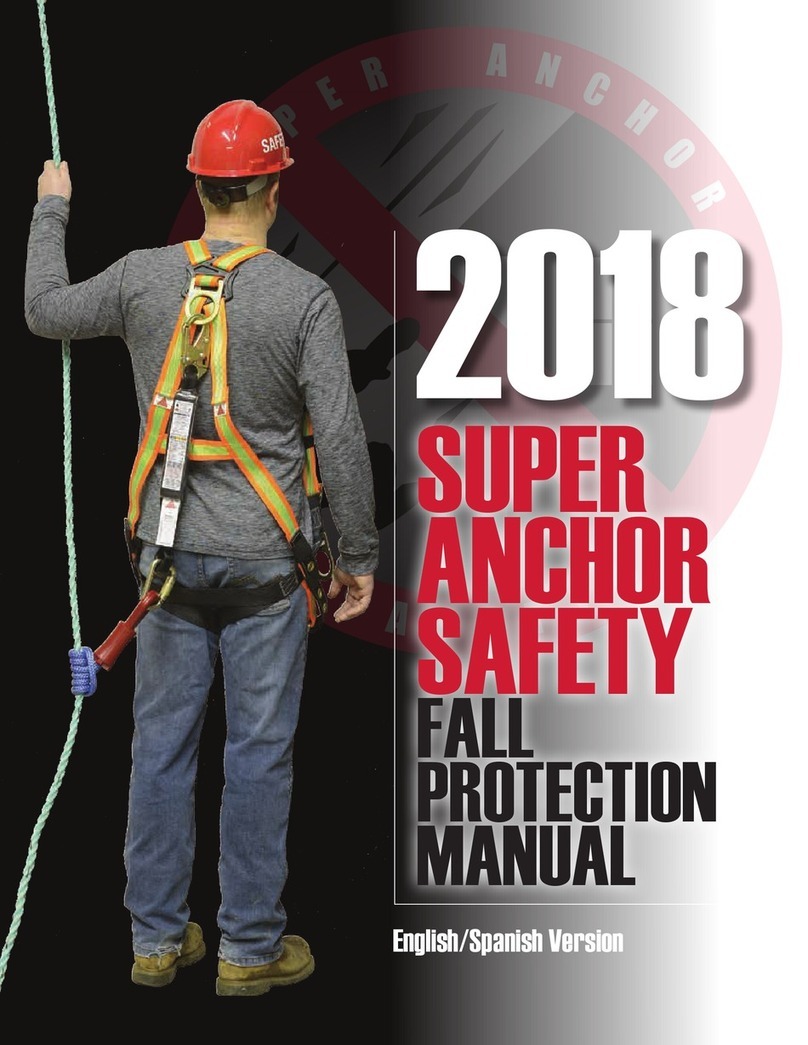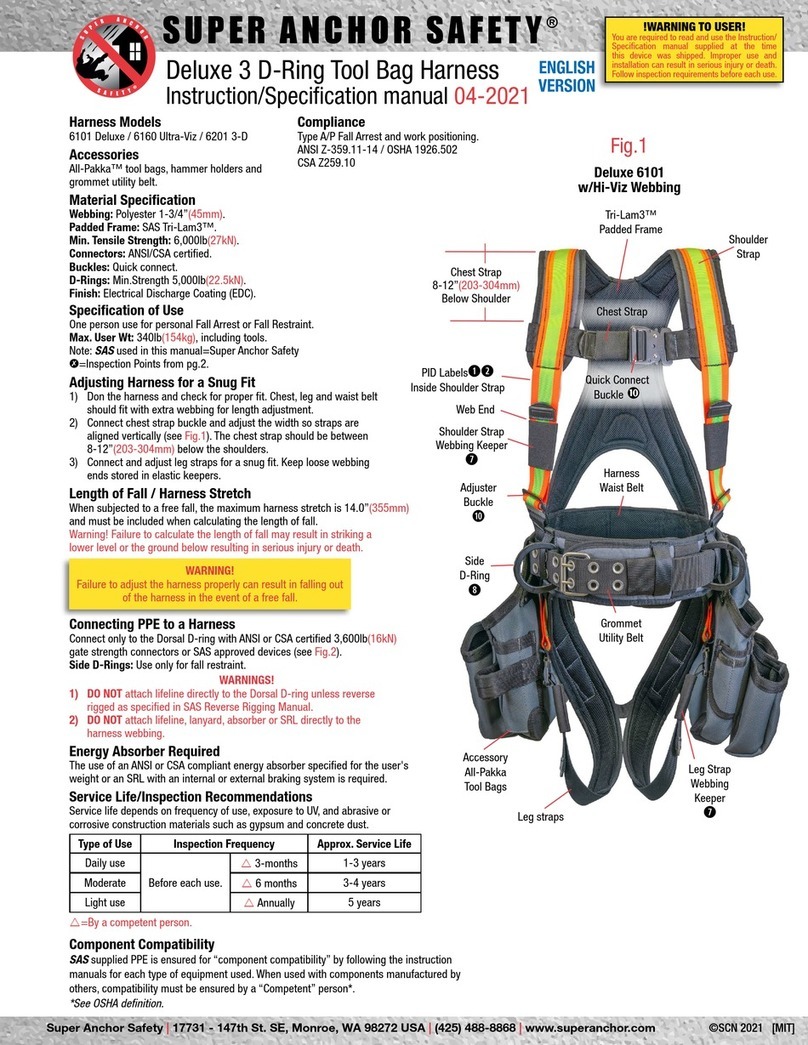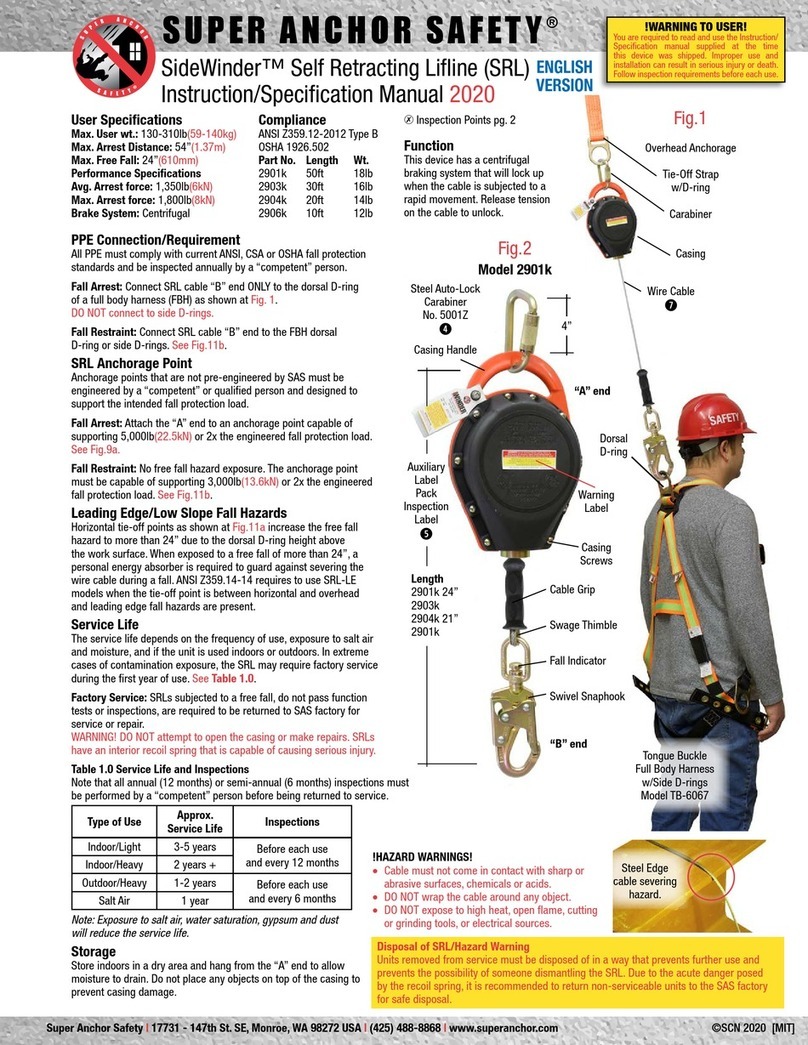
Example:
Front shoulder strap attachment
to SAS No.6001 harness.
Example:
Leg strap attachment to SAS
No.6101 Deluxe™ harness.
Attachment to Harness Webbing
For harnesses with continuous loop shoulder straps,
feed cinch strap between webbings.
Fig.3
Fig.6
Fig.8
Fig.4 Fig.5
Compliance/Prompt Rescue
Performance standards for webbing type Trauma Suspension
Ladders (Trauma Relief Systems) are not currently published
by Fall Protection regulatory agencies. SAS recommends
consulting a certified professional safety consultant (CSP) to
develop a plan for rescue and use of this type of equipment.
Instructions regarding training and use of such devices may
be found in the following documents.
OSHA 1926:502(d)(20)
“Employers shall provide for prompt rescue of employees in
the event of a fall or shall assure that employees are able to
rescue themselves.”
ANSI Z359.1-07
Sec.7.3.2 “what to do after a fall to protect the user from
injury. Emergency rescue planning.”
ANSI Z359.2-07
Sec.5.5 “Inspection/maintenance for rescue devices.” Sec.6
Rescue Procedures. 6.1 “The employer shall provide prompt
rescue to all fallen authorized persons training for self rescue.”
CSA Z259.10-06 Annex A Non-mandatory.
Sec.A.4 (g) “injury due to suspension trauma must be reduced
to a minimum.” (h) “It is recommended that a device be used
for this purpose.”
Compatibility
Attach to SAS full body harnesses as shown at Figs.3-7.For harnesses
mfg. by others compatibility should be ensured by a competent person.
Chinch
Strap
Chinch
Strap
Chinch
Strap
Storage
Pouch
Continuous
Loop Shoulder Strap Leg Strap
Feed storage pouch through the
cinch strap and tighten.
Storage Pouch
Back Side
Hook/Loop
Straps
To prevent movement
secure storage pouch
to harness webbing
with hook/loop strap.
Back Side
Leg Strap
Attachment Options
Figs.3-7 are suggested attachment
methods. Alternate attachment
methods may be used if specified by
a competent person.
Warning! The cinch loop must be
secured to the harness in a way
that will prevent movement during
suspension.
Note: When fitted with tool bags the
the storage pouch will be partially
covered.
Fig.7
SUPER ANCHOR SAFETY®
©SCN 2022 [MIT]
Page 2English Version
Trauma Suspension Ladder manual 2022
EMERGENCY INSTRUCTIONS!
1) Ensure ladder is attached to harness as
shown in instruction manual.
2) Deploy ladder.
3) Insert feet into foot loop.
4) Extend legs to lift body weight.
5) Adjust foot position for comfort.
6) WARNING ! DO NO USE FOR RESCUE
HOISTING OR LIFTING.
INSTRUCTIONS EN CAS D’URGENCE !
1) Assurez-vous que l’échelle est fixée au
harnais tel qu’illustré dans le manuel
d’instructions.
2) Déployez l’échelle.
3) Insérez les pieds dans la boucle.
4) Étendez vos jambes afin de soulever le
poids de votre corps.
5) Ajustez la position de vos pieds pour
plus de confort.
6) AVERTISSEMENT ! NE PAS UTILISER
POUR LEVER OU DESCENDRE
QUELQU’UN LORS D’UN SAUVETAGE.
INSTRUCCIONES DE EMERGENCIA
1) Asegurar que la escalera se sujete al
arnés como se muestra en el manual de
instrucciones.
2) Despliegue la escalera.
3) Meta los pies en el lazo para pies.
4) Extienda las piernas para levantar el
peso corporal.
5) Ajuste la posición de los pies para mayor
comodidad.
6) ¡ADVERTENCIA! NO LO USE
PARA ELEVACIÓN DE RESCATE O
LEVANTAMIENTO.
Made in China
6060-1.1 01-2022 ©SCN [MIT]
Emergency
Instructions
Emergency Instructions
English/French/Spanish instructions
are sewn to the ladder webbing.
Ladder Bundle
To deploy, remove ladder
from storage pouch and
unfurl. To re-use, bundle
ladder as shown here and
place in pouch.


























